
The Long March 5 (Y2) rocket being rolled out at Wenchang Satellite Launch Centre on June 26, 2017.
2.03.2017
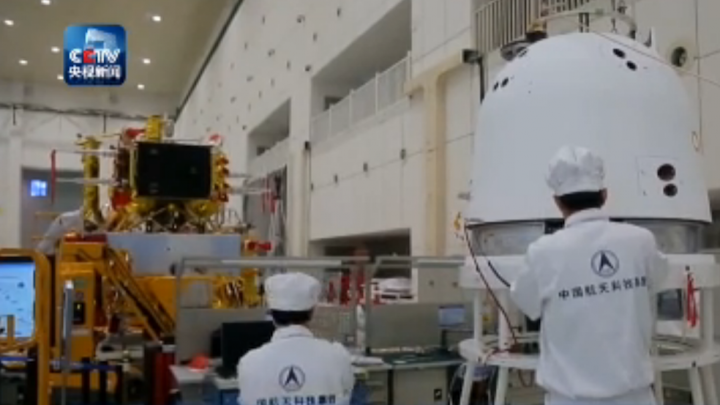
China's lunar probe Chang'e-5 will be delivered to the Wenchang launch site in August in preparation for its launch by a heavy-lift Long March 5 rocket in late November.
Ye Peijian, a senior official involved in lunar exploration and attached to the China Academy of Space Technology (CAST), confirmed the move to China Central Television ahead of the country's annual parliamentary sessions in Beijing.
The complex mission will involve a number of stages and components, involving lunar soft-landing, collecting samples, ascent from the Moon, a docking in lunar orbit, heading home and reentry into the Earth's atmosphere.
The plan will be for operations on the Moon to take place within a lunar day, and the mission completed before the end of 2017, with a reentry capsule carrying up to 2kg of lunar regolith to a landing spot in Siziwang Banner in Inner Mongolia.
The mission marks the final stage of the country's three-step lunar exploration project that has seen two orbiters and a lander and a rover explore the Moon. But new plans are already underway.
Future lunar missions include the Chang'e-4 probe which will attempt the first ever landing on the lunar far side in late 2018, utilising the backup lander and rover from the Chang'e-3 mission.
China will then target the north and south poles of the moon, Ye says, to undertake surface exploration, resource development and related technology validation.
The lunar poles are of tremendous scientific interest and could offer new insights into the origins and evolution of the Earth-Moon system and the solar system itself, and could also be extremely useful in terms of resources and for future human outposts.
Quelle: gbtimes
---
But the country's ambitions won't stop there, according to Ye Peijian, a chief commander of the China Lunar Exploration Project (CLEP).
Ye told media on Wednesday that the pioneering Chang'e-4mission to the lunar far side in late 2018 - utilising the backup lander and rover from the Chang'e-3 mission - will kick off a brand new fourth phase of exploration.
The mission involves first sending a relay orbiter to a Lagrange point beyond the Moon in summer 2018 to facilitate communications with the lander and rover on the lunar far side, which due to tidal locking never faces Earth.

Above: A view of the far side of the Moon and the distant Earth, captured by the service module for the 2014 Chang’e 5-T1 mission (Chinese Academy of Sciences).
Later missions will then target the north and south poles of the moon, Ye says, to undertake surface exploration, resource development and related technology validation.
The lunar poles are of tremendous scientific interest and could offer new insights into the origins and evolution of the Earth-Moon system and the solar system itself, according to a 2012 paper by Ian Crawford, a professor of planetary science and astrobiology, and others.
The lunar poles also potentially contain areas of water ice, preserved in permanently shadowed craters, and other places almost permanently bathed in sunlight, both of which could be extremely useful in terms of resources and for future human outposts.
The missions are likely to take place in the early to mid-2020s.
More immediately the Chang'e-5 probe will be shipped to the Wenchang Satellite Launch Centre on Hainan island in August in preparation for launch on a Long March 5 rocket in late November.
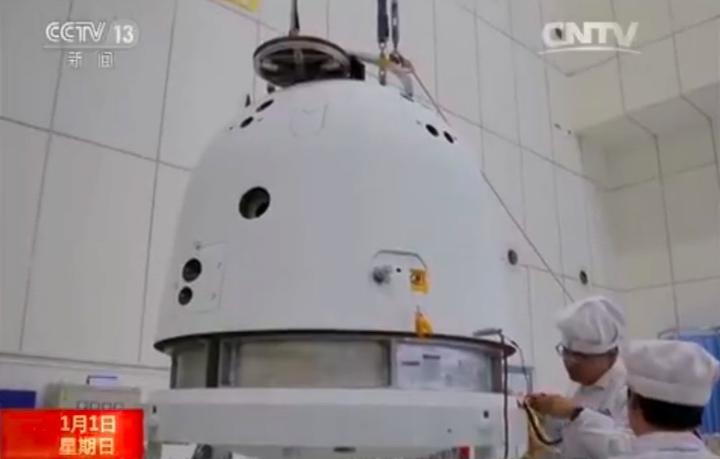
Above: The Chang'e-5 reentry capsule (Framegrab/CCTV).
The mission will feature China's first automated moon surface sampling, and the first such mission by any country for over 40 years.
The complex mission involves landing on the Moon, collecting samples, take-off, and an unmanned docking in a lunar orbit about 380,000 km from Earth, and returning home at a speed close to second cosmic velocity, testing reentry technology.
Should Chang'e-4 and Chang'e-5 be successful, the backup sample return probe Chang'e-6 is expected, though not officially approved, to attempt a sample return from the far side, possibly around the lunar polar regions.
"China is also preparing for the exploration of asteroids and Jupiter, as part of its plans for deep-space exploration," Ye Peijian told Xinhua (Chinese).
Such plans were noted in the Chinese government's space policy 'white paper' released in December.
Ji Jianghui, a researcher at Purple Mountain Observatory under the Chinese Academy of Sciences, in February outlined a proposal for asteroid sampling.
The mission would see China launch a probe in 2022 to first fly alongside and orbit near-Earth asteroid Apophis, then flyby asteroid 2002 EX11, and finally rendezvous with and land on asteroid 1996 FG3.
Quelle: gbtimes
---
Update: 7.06.2017
.
China's Chang'e 5 lunar probe is expected to land in the Mons Rumker region, and to take moon samples back to earth at the end of the year, according to a Chinese space official.
Liu Jizhong, director of China Lunar Exploration and Space Engineering Center of China National Space Administration (CNSA), for the first time disclosed the probe landing site, an isolated volcanic formation located in the northwest part of the Moon's near side.
Liu also mentioned China's Chang'e 4 lunar probe. Delivering a report at the Global Space Exploration Conference, which opened in Beijing Tuesday, he said China's Chang'e 4 lunar probe, which is expected to be the first human carrying probe landing on the far side of the moon, would be launched in 2018, carrying 11 scientific payloads, including four developed by other countries.
He said lunar exploration had many international cooperation opportunities and that constructing the international moon village or international research station, proposed by European Space Agency (ESA), was also a long-term goal for China.
"China is planning and designing its future lunar exploration program. We will focus on the south pole region of the moon. The research on water and the permanent shadow area of the lunar south pole region will bring greater scientific discoveries," Liu said.
He said that China would push forward international cooperation in exploring the south pole of the moon, constructing lunar scientific research station and establishing long-term energy supply and autonomous infrastructures.
Liu proposed jointly exploring the lunar polar region and constructing the scientific research station as a guide for the international moon village or station, following international law.
He also proposed creating an open platform for cooperation in accordance with the principle of "sharing the risks and achievements," and to set up the International Union of Planetary Scientists and the International Union of Planetary Science College Students.
He said scientists from different countries might jointly formulate scientific objectives, develop scientific payloads and carry out scientific data research.
"Partners may develop probes and facilities independently, which will complement each other. Enterprises are also encouraged to actively participate in lunar exploration," Liu said. "Intergovernmental cooperation should be strengthened, and governments should co-ordinate existing deep space exploration infrastructures to share the resources and enhance investment efficiency."
At the conference, Wu Yanhua, vice administrator of CNSA, honored the international partners of China's Chang'e 4 mission, which will carry payloads from the Netherlands, Germany, Sweden and Saudi Arabia.
Since China proposed international cooperation on the Chang'e 4 mission last year, China has received more than 20 schemes from other countries.
"We support more international cooperation in China's future lunar and Mars missions, as well as exploration to the Jupiter system and asteroids that are still under discussion," Wu said.
"It is exactly what I was looking forward to," said Jan Woerner, director general of the ESA. "It will fit perfectly to the moon village, ESA's vision for international cooperation on the moon."
Quelle: Xinhua
---
Update: 5.07.2017
.
Yuanwang-3 completes ship check mission, ready for Chang'e-5 lunar probe launch
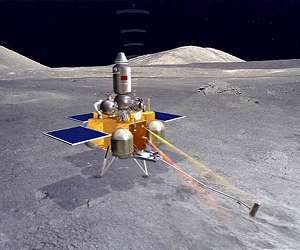
Chinese space-monitoring ship Yuanwang-3 has completed a 27-day maritime calibration mission and returned to port in east China's Jiangsu Province Thursday.
The ship will take part in six maritime space monitoring missions as a part of the space expeditions scheduled for the second half of the year, which will include the launch of the Chang'e-5 lunar probe and BeiDou-3 satellite.
Yuanwang-3 has embarked on more than 40 expeditions in the Pacific, Indian and Atlantic oceans, sailing more than 580,000 nautical miles.
Apart from the missions assigned to Yuanwang-3, Yuanwang series vessels will carry out a total of 16 maritime space monitoring missions in the latter half of this year.
The Yuanwang-1 and Yuanwang-2 ships were China's first-generation space tracking vessels, which first entered service in late 1970s, making China the fourth country to master space tracking technology after the United States, Russia and France.
Quelle: SD
---
Update: 26.04.2018
.
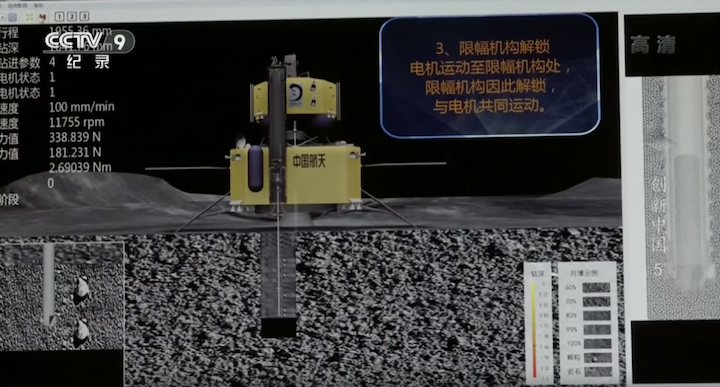
Chang'e-5 lunar sample return drilling simulation tests, being carried out by the China Academy of Space Technology. Framegrab/CCTV
-
China is planning to launch its ambitious lunar sample return mission, Chang'e-5, in 2019, once the required Long March 5 heavy-lift rocket has successfully returned to flight.
Pei Zhaoyu, deputy director of the Lunar Exploration and Space Program Center of the China National Space Administration (CNSA), told a space conference marking China's Space Day on Tuesday that the complex, four-part spacecraft will liftoff next year.
The Chang'e-5 spacecraft includes a service module, lander, ascent unit, and a return vehicle. After soft-landing on the Moon and collecting around 2 kilograms of samples, the ascent module will blast off into lunar orbit where it will need to dock with the service module, close to 400,000 kilometers away from Earth.
The samples will be transferred from the ascent vehicle to the reentry capsule, which itself will separate from the service module a few thousand kilometres from Earth before reentry and landing in Siziwang Banner in Inner Mongolia.
Chang'e-5 was due to launch in November 2017, but the failure last July of the second launch of the Long March 5, the heavy-lift launch vehicle required for the mission, has pushed the mission back.
After isolating the cause of the failure and implementing a redesign of cryogenic YF-77 engines for the rocket's first stage, the third Long March 5 is set to launch around November.
A nominal flight would clear the way for the fourth Long March 5 to launch Chang'e-5 from the Wenchang Satellite Launch Centre next year, as well as marking an important step for the Chinese Space Station project.

The Long March 5 (Y2) rocket being rolled out at Wenchang Satellite Launch Centre on June 26, 2017.
The last lunar sample return mission, the Soviet Union's Luna 24 probe in 1976, saw the return capsule head directly back to Earth from the Moon's surface.
The added complexity of Chang'e-5 in lunar rendezvous and docking suggests China is looking to gain experience for future lunar projects and Mars sample return missions, as well as potential crewed Moon landings in the 2030s.
Preparations for the mission, including tests and simulations, have been taking place in Beijing at the China Academy of Space Technology (CAST), a developer and maker of satellites and spacecraft.
China has already tested rendezvous and docking in low Earth orbit, with crewed and uncrewed Shenzhou spacecraft with the Tiangong-1 and Tiangong-2 spacecraft, as well as the Tianzhou-1 cargo vessel visiting the latter last year.
Performing the feat in orbit around the Moon brings new challenges. The distances involved and speed of light means delays in sending messages to and from the Earth, thus requiring automation.

Chang'e-5 lunar orbit docking simulation tests, being carried out by the China Academy of Space Technology.
The Chang'e-5 lander will set down near Mons Rümker in Oceanus Procellarum, a large area of lunar mare in the northwest region of the Moon.
The selection of such a site means China could return the youngest lunar basaltic samples so far, with spectral analysis from Chandrayaan-1 Moon Mineralogy Mapper data indicating a surface age of around 1.33 billion years old.
In contrast, the basalt samples collected by the Apollo missions were 3 to 4 billion years old.
The mission will also be assisted with ground station support from the European Space Agency for launch and landing, and cooperation may also be extended to analysis of samples once back on Earth.

Scientists working on China's Chang'e-5 reentry vehicle, right, with lander and ascent vehicles in the background.
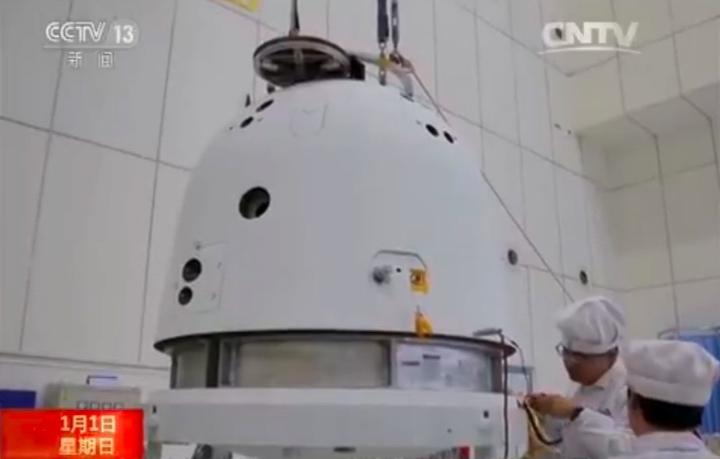
As the Chang'e-4 probe made the first-ever soft landing on the far side of the moon, a senior Chinese space expert said China will deepen its lunar exploration and venture further into the unknown.
China's current lunar program includes three phases: orbiting, landing, and returning. The first two phases have been accomplished, and the next step is to launch the Chang'e-5 probe to collect 2 kg of samples and bring them back to the earth, said Wu Weiren, an academician of the Chinese Academy of Engineering and chief designer of China's lunar exploration program.
There are still many mysteries about the earth's nearest heavenly neighbor and future missions will be more exciting. The program will also promote China as a major player in space exploration.
"We are discussing and drawing up the plan for the fourth phase of the lunar exploration program, including missions to the polar regions of the moon," Wu said.
Some places at the south pole of the moon receive sunlight for over 180 consecutive days, and some areas in craters there are never exposed to sunlight and might hold frozen water, scientists say.
"We hope to build a scientific research station in the south polar region of the moon. It would be operated automatically and visited by people for short periods," Wu envisioned.
China is also planning to launch a probe in 2020 that would orbit, land and rove on Mars the following year.
A heavy-lift carrier rocket, with a takeoff weight of about 4,000 tonnes and a diameter of 10 meters, is a goal for 2030. It would help realize the aim of bringing Mars samples back to the earth and sending Chinese astronauts to the moon.
China is becoming a major player in lunar exploration, and contributing to scientific discovery.
"Exploring the unknown is human nature. The moon is a mysterious world to us. We have a responsibility to explore and to understand it. Exploration of the moon will also deepen our understanding of earth and ourselves," Wu said.
China unveils on Tuesday more details about the Chang'e-5 probe, which will undergo multiple flight phases before the mission is completed.
The probe, to be launched by the end of this year, will enter the Earth-moon transfer orbit. It will slow near the moon to enter the lunar orbit and descend and land on a pre-selected area for ground research work, including collecting lunar samples, said Peng Jing, deputy chief designer of the probe from the China Academy of Space Technology, at a press conference.
After finishing its work on the moon, the ascender will rise from the lunar surface for rendezvous and docking with the orbiter flying around the moon. Then the returner will fly back to Earth via the Earth-moon transfer orbit, reenter the atmosphere and land at the Siziwang Banner (County) of Inner Mongolia Autonomous Region, Peng said.
The lunar samples taken back by the Chang'e-5 probe will be sealed in a container and sent to labs for further analysis and research, he added.
The probe can be divided into 15 sub-systems, including structure, thermal control, antenna, sample collecting and sealing and propulsion. It is composed of an orbiter, a returner, a lander and an ascender.
The Chang'e-5 probe will be launched from Wenchang Space Launch Center in southern Hainan Province.
Quelle: Xinhua
----
Update: 22.07.2019
.
Fifty years ago, when Apollo 11 blasted off from the Moon for its return to Earth, Moon-walkers Neil Armstrong and Buzz Aldrin took with them 22 kilograms of rocks – the first in a trove of 382 kilograms that would be returned by the Apollo program in the next three years.
Since then, nobody else has walked on the Moon, and the only other samples ever brought back were 301 grams of material collected in the 1970s by a trio of Soviet missions called Luna 16, Luna 20, and Luna 24.
Early next year, however, China is poised to be the first to fill this gap, via a robotic mission designed to land on Mons Rümker, a sprawling volcanic ediface believed to contain some of the Moon’s youngest volcanic rocks.
The mission, called Chang’e 5 (CE-5), is part of China’s Chang’e program, named for the ancient Chinese goddess of the moon.
In 2018 and early 2019, CE-4 and a sister mission called Queqiao landed a rover on the far side of the Moon and positioned a communication satellite in an orbit high above the Moon’s far side, where it could relay communications from the rover back to Earth. (Radio signals cannot be beamed directly to Earth from the far side, because the Moon is in the way.)
Upcoming missions, scheduled for later in the 2020s, are intended to bring back a second sample – this one from the Moon’s south polar region – and to practise 3D printing techniques on the Moon in the hope that they can be used to help construct a permanent robotic research station, Chunlai Li of the Chinese Academy of Sciences in Beijing and colleagues wrote last week in the journal Science.
Lunar reseacher Richard Carlson, a geochemist and geochronologist at the Carnegie Institution for Science in Washington, DC, is excited about the idea of getting new samples.
One of the shortcomings of the current crop of samples, he says, is that they all come from simlar parts of the Moon – specifically from plains on its near side.
Not that there weren’t good reasons for picking such sites: flat landing sites were safer, and it was necessary to keep in radio contact with the astronauts. But geologically, the near side of the Moon is very different from the far side.
“[From] global composition maps, it’s pretty clear that the surface in that area is unusual,” Carlson says. Just to begin with, “it is covered in lava flows, and lava flows are rare on most of the Moon except the Earth-facing side”.
Since our understanding of the Moon is largely built from these samples, he says, it would be nice to get samples from the other side, just to make sure that what we think we know about the Moon as a whole does indeed apply to all parts of it.
Also interesting, he says, would be to get samples from a giant, 2500-kilometre, far-side crater known as the South Pole-Aitken Basin, which appears to have been created by an impact so powerful it may have bored all the way through the Moon’s crust and blasted out rock fragments from its mantle. (CE-4’s landing site was within this basin, but CE-4 was not a sample-return mission.
“You can see minerals on the surface that look like the kind you would expect to be in the lunar interior,” Carslon says.
In their paper, Li’s team tout the Chang’e project’s opportunities for interntional cooperation, citing ongoing collaborations with a more than a half-dozen countries, including Germany, Sweden, The Netherlands, Russia, Ethiopia, Turkey and Pakistan.
Notably absent from the list, however, was the US.
That, Carlson says, is because of a 2011 law pressed by US Congressman Frank Wolf (R-VA, now retired), which banned NASA from many types of cooperation with China without congressional approval.
“Wolf was very concerned about the Chinese stealing technology,” Carlson says, “so he put a cap on the ability to work with Chinese scientists, at least with NASA support.”
That said, Scientific American reported last February that NASA was allowed to coooperate with CE-4 by using its Lunar Reconnaissance Orbiter to assist the Chinese investigations at CE-4’s landing site.
Li’s team suggests that future cooperation might start with exchange of scientific data –presumably including information learned from the samples returned by upcoming missions.
And while it isn’t clear how large are the samples that might be returned by these missions, Carlson notes that with today’s analytical techniques, they don’t have to be huge to be gold mines of information.
“The quantities aren’t the big point,” he says. “A robotic lander that could bring back even a handful of stuff could bring back a lot of information.”
Quelle: COSMOS
----
Update: 28.10.2019
.
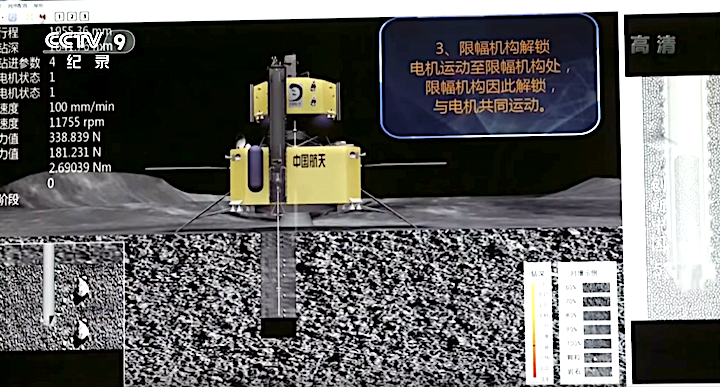
China plans to launch the Chang'e-5 probe in 2020 to bring moon samples back to Earth, according to Wu Weiren, chief designer of China's lunar exploration program.
The Long March-5 carrier rocket, China's current largest launch vehicle, will be used to send the probe into space, Wu, also an academician of the Chinese Academy of Engineering, said at the first China Space Science Assembly, which opened Saturday in Xiamen, east China's Fujian Province.
The second Long March-5 rocket was launched from the Wenchang Space Launch Center in the southern province of Hainan on July 2, 2017, but a malfunction happened less than six minutes after its liftoff.
China's space engineers have spent over two years looking for the cause of the malfunction. The third Long March-5 rocket is being transported to the Wenchang Space Launch Center for a new flight, according to Wu.
The success of the flight will be the key for China's future space missions including the Chang'e-5 probe.
Wu said the Chang'e-5 probe includes a lander, an orbiter, an ascender and a returner. The key of the mission will be lunar sample collection, takeoff from the moon, rendezvous and docking on lunar obit and high-speed reentry into Earth' atmosphere.
China's current lunar program includes three phases: orbiting, landing, and returning. The first two phases have been accomplished, and the next step is to launch the Chang'e-5 probe to collect 2 kg of moon samples and bring them back to the earth.
China is also drawing up the plan for the fourth phase of the lunar exploration program.
In the fourth phase of the program, China will conduct scientific detection in the south polar region of the moon by mainly using high intelligent robots, and realize long-term exploration in the complicated lunar environment, Wu said.
There might be some ancient craters and frozen water at the south pole of the moon, which is of great research value, said Wu.
Quelle: Xinhua